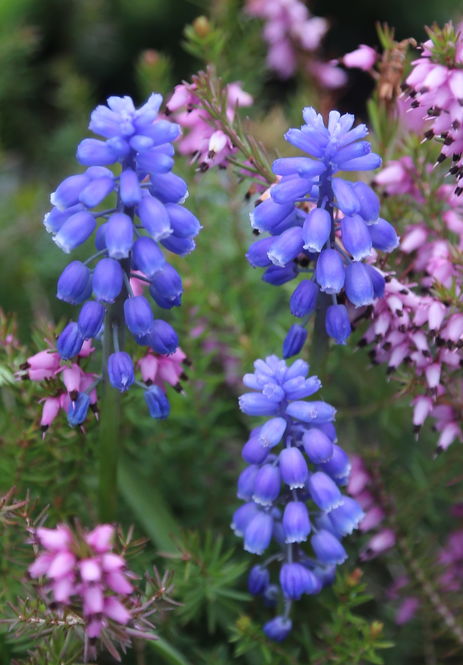Notes from the Chairman’s Gardens

The appearance in my garden during early April of the crisp blue candle-like flowers of the Grape-hyacinth is always a heart warming sight, that brings delight. Previously in the plant family Liliacea, as a result of recent DNA research the genus Muscari has now been placed within Asparagaceae; which includes other horticultural gems such as Agave, Asparagus, Chlorophytum, Dracaena, Hyacinthus, Ornithogalum and Scilla.
These small bulbs pack a huge visual punch for their size but somehow I cannot help but think that like many other common garden plants we are perhaps on occasions inclined to take them a little too much for granted. However, it is quite wrong to do so as it is these often-neglected stalwarts that are in fact the true backbone of a good garden. Being reliable, non-demanding, colourful and tough, they basically just get on with life; it is this magical quality that for me makes them all the more valuable and deserving of my appreciation. Give me core workers such as that in a planting scheme any day over the myriad of delicate treasures that demand my attention by being fussy about soil conditions, aspect and overall growing conditions. Having a small garden I also rigorously apply the ‘three-task rule’ to my plant choices; what is that? Basically each species or cultivar that I grow has to have three specific attributes and an ability to do three jobs; otherwise it simply does not get in the gate. These wee guys meet this criterion with ease, being early flowering, having good shape and a pleasing texture; add to that splendid long lasting flowers; superb scent and the fact that they can be cut for use indoors in a table vase and you have a winner.
The genus Muscari contains about fifty species, which naturally occur from Southern Europe through the Mediterranean into the Balkans, Caucasus and Turkey; where they are found naturally in woodland and mountain screes. The most widely grown species are Muscari armeniacum, Muscari azureum, Muscari botryoides and Muscari neglectum. All are now naturalised in parts of the British Isles especially southern England but including parts of the Lothian’s and the Scottish Borders.
The plant order Asparagales, to which the hyacinth family belongs is recent in terms of evolution with its origins dating back the Mid Cretaceous around 100 million years ago. Whilst the divergence of Muscari from the main crown group is thought to have taken place much more recently; a better understanding will only be acquired with further research and improved fossil evidence.
The generic name is derived from the Greek word moschos or musk, which is appropriate as some species have a distinct musky fragrance; the specific epithets armeniacum refers to Armenia, azureum, to the ‘azure colour of the flowers’, botryoides meaning ‘like a bunch of grapes’ and neglectum simply ‘overlooked’.
Grape-hyacinths are an important early season food source for Honeybees Apis mellifera, as well as for other Short and Long-tongued Bumblebees, plus Solitary Bees, especially foraging Queens. The flowers are also visited by Bee Flies including Bombylius fuliginosus and B. medius. The actinomorphic bisexual flowers (each having both male and female reproductive parts) produce both pollen and nectar; generally insect pollinated they are also on occasions self-fertile. If you study the racemes closely you will see that the tiny individual flowers that make up the spike, only open a few at a time in sequence from the base upward; this mechanism has evolved to ensure the maximum possible opportunity for successful pollination in constantly changing weather conditions, especially temperature so vital for the germination of the pollen grain.
It is not known exactly when or who first introduced the genus into the gardens of the British Isles; the botanist John Parkinson [1567-1650] speaks favorably of it in his famous work Paradisi in Sole Paradisus Terrestris – a garden of all sorts of pleasant flowers (1629) where the distinct flowers are also clearly and accurately illustrated. William Curtis [1746-1799] describes M. botryoides in the Botanical magazine or Flower-garden displayed BM 157. Vol 5. (1792) the text being accompanied with a fine coloured drawing. Phillip Miller [1691-1771] details their propagation in Millers Gardeners Dictionary (1743). Later both John Abercrombie [1726-1806] and John Claudius Loudon [1783-1843] extoll the virtues of Grape Hyacinths in their now famous works the Gardeners Kalender and the Encyclopedia of Gardening, both published in numerous editions between 1767 and 1848.
Tough and dependable Grape-hyacinths are hardy throughout most of Scotland making them a great choice for early spring colour. They are best planted at about 10cm deep in full sun, in a well-drained spot augmented with a little well rotted leaf-mould or garden compost if you have it. In later life about once every four to five years they will benefit from being lifted and split when dormant during the summer months; this helps to maintain vigour whilst also providing an opportunity to gift a few to friends or neighbours.
The different species and cultivars vary in size, habit and growth rate, all have narrow strap or needle like leaves between 5cm to 30cm in length. The cone shaped racemes of densely packed tiny blue flowers are generally about 8cm in height, each sitting on a stalk or peduncle varying between 8cm to 30cm long.
When deciding which ones to grow it is worth remembering that M. armeniacum is very strong growing, even becoming a little invasive in some situations; many gardeners also dislike it due to the lanky eventually scruffy foliage. Personally, I feel that it is best naturalised in longer grass where it makes a great contrast with bright yellow dandelion flowers so vital for bees early in the season. For use in the border I much prefer either M. azureum or M. botryoides as both are much better behaved; the latter having shorter tidier foliage and erect flower spikes making it easier managed in a small garden. The many different sizes, shades and colours to be found in the range of cultivars includes pale blues, dark blues, violets and pure whites; all are fine if you like that sort of thing but for me it is the ‘auld yins that are the best’ being tried, tested and somehow full of confidence.
Whatever type you choose, all look great in the woodland border, the wild garden or in a mixed border; you can even place them under taller shrubs including roses or just pop them in a corner of the rock garden, by the side of a path, in a tub or a window box. Basically, put them anywhere you like so long as it is sunny, well drained and ideally in a location where you can also enjoy the blooms from inside the house as you look out towards the garden on a cold morning. I grow mine in the front garden in full sun in the company of winter heaths, including Erica carnea ‘Springwood White’ and E. carnea ‘Springwood Pink’ both of which make a nice foil to the bright blue flowers.
Like hyacinths, Muscari are linked to the myth of Hykinthos and therefore have come to represent grief and death in some western cultures; interestingly recent archaeological evidence based on pollen studies from Neanderthal grave sites indicates that they were perhaps used in ritual burials over 50,000 years ago. Since the Middle Ages Muscari and its close relatives have been considered to be a symbol of Christ and as such they were frequently depicted in Renaissance nativity scenes.
Although the bulbs contain alkaloids including colchicine, which has medicinal uses, they have been little used in traditional medicine, most likely because they are highly toxic. Long used in the art of perfume manufacture today some of the more heavily scented species are still cultivated on a large scale in parts of Europe so that the flowers can be harvested specifically for industrial purposes.
The Plant Finder lists a wide variety of species and cultivars, all of which are readily available from a wide range of nurseries including specialist, many of which offer a mail order service. Please remember that several species are threatened with extinction in the wild due to habitat loss and illegal harvesting; therefore also try to ensure that what you are buying is actually propagated and produced by the nursery, ideally here in the UK. Go on plant a ‘weel knawin face’ and enjoy the rewards that it brings.
Mad about plants? Learn about Magnolia stellata.


